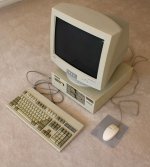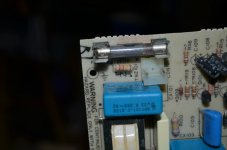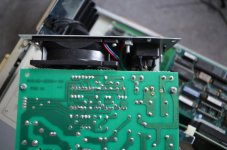Well, it's garage sale season again in my area. The beauty of this season is that I can never plan how I'd be surprised next. As a 386 guy, my wish-list was full of 386 stuff but nothing earlier than that. Up until recently, I occasionally came across this guy (as pictured). It was a 8088 based XT clone, Acer-710. Although I was not really expecting to extend my retro hobby that far backwards, I decided to take the given chance and explore it for fun.
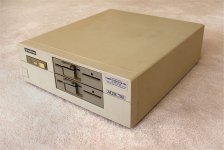
What I found under the cover:
- CPU 8088-1 10Mhz (or 4.77Mhz in non-turo mode)
- 768kB 120ns memory in massive array of DIP chips
- Integrated CGA/MDA/MGA video
- Two 5.25" 360k floppy drives
- Minicribe 8438 31M hard disk
- Adaptec ACB-2072 RLL controller card
- One parallel port and one serial port
The manufacturer spec is available here:
http://classictech.files.wordpress.com/2010/03/1987-acer-presskit-acer-technologies-targets-comdex-to-make-pc-industry-debut-6-1-87.pdf
and the mobo documentation here:
http://stason.org/TULARC/pc/motherboards/A/ACER-INC-8088-ACER-710.html#.UZ42S4JdX10
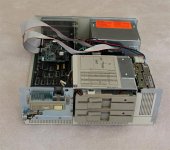
It might not be an ideal candidate for any ultimate retro project due to its less-customizable integrated mobo. But all I wanted to do was to make it working, so that I could revive my old school BASIC/Fortran/C codes on a true 8088 PC. The machine came without any peripherals -- no monitor, no keyboard and no mouse, which yielded a bit of challenges in my home lab with merely AT/ATX stuff. The first thing I wanted to avoid was to hunt for a space-taking 9-pin monitor, although I did miss the CGA look & feel for a long time. Instead, I quickly dropped in a generic Trident 8900C VGA card and fired it up with a 17" VGA CRT. The good news was that the machine beeped and passed the memory test, the bad news was that the HD didn't spin up. I was also a little bit disappointed about the silence during the memory test (in either fast or slow test mode). I loved to hear the tick sound as a kind of feedback from counting those very expensive silicon bytes at that era.
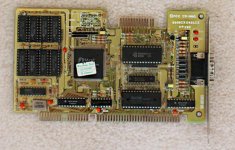

After several power on/off, the HD finally spun up loudly (compares to those early IDE HDs). I then discovered that I have to power it on everyday or otherwise it would randomly choose a day as its holiday. Another interesting thing was that the RLL controller card refused to work with all my 386DX motherboards but worked well at the first kiss with my PIII motherboard. It was fancy (for a newbie) to see such a cross-century marriage between RLL HD and PIII 1GHz Coppermine. There could be something to do with the BIOS I thought. But anyways, this allowed me to easily dump MS-DOS 3.30 and many other software to the HD (without via the 5.25" 360 disk). I've also managed to install Windows 3.0 in VGA mode with an effective help from this thread:
http://www.vintage-computer.com/vcforum/showthread.php?35593-Windows-3-0-VGA-color-driver-for-8088-XT
The true trouble started with the keyboard. The oldest keyboard I could find didn't work, although it physically had a correct 5-pin DIN head. I've then recalled a "common sense" that AT keyboards are not XT compatible. The issue was thoroughly discussed in this thread:
http://www.vintage-computer.com/vcforum/showthread.php?15907-AT-to-XT-Keyboard-Converter
So, before I decided to follow the guide and build the convertor with a PIC chip, I asked myself why not just open the keyboard and speculate in? I was happy to see that the controller IC in it was a well documented IC. After I desoldered the jumper wire from the pin #1, the keyboard could be *sometimes* recognized by the XT box, which was a good sign. I then soldered a 1k resister from pin #1 to +5v, which reliably locked the keyboard in XT mode. I was lucky enough because the IC in this keyboard had both XT and AT logic in its ROM and was switchable by pin #1.
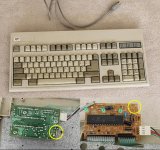

What I found under the cover:
- CPU 8088-1 10Mhz (or 4.77Mhz in non-turo mode)
- 768kB 120ns memory in massive array of DIP chips
- Integrated CGA/MDA/MGA video
- Two 5.25" 360k floppy drives
- Minicribe 8438 31M hard disk
- Adaptec ACB-2072 RLL controller card
- One parallel port and one serial port
The manufacturer spec is available here:
http://classictech.files.wordpress.com/2010/03/1987-acer-presskit-acer-technologies-targets-comdex-to-make-pc-industry-debut-6-1-87.pdf
and the mobo documentation here:
http://stason.org/TULARC/pc/motherboards/A/ACER-INC-8088-ACER-710.html#.UZ42S4JdX10

It might not be an ideal candidate for any ultimate retro project due to its less-customizable integrated mobo. But all I wanted to do was to make it working, so that I could revive my old school BASIC/Fortran/C codes on a true 8088 PC. The machine came without any peripherals -- no monitor, no keyboard and no mouse, which yielded a bit of challenges in my home lab with merely AT/ATX stuff. The first thing I wanted to avoid was to hunt for a space-taking 9-pin monitor, although I did miss the CGA look & feel for a long time. Instead, I quickly dropped in a generic Trident 8900C VGA card and fired it up with a 17" VGA CRT. The good news was that the machine beeped and passed the memory test, the bad news was that the HD didn't spin up. I was also a little bit disappointed about the silence during the memory test (in either fast or slow test mode). I loved to hear the tick sound as a kind of feedback from counting those very expensive silicon bytes at that era.


After several power on/off, the HD finally spun up loudly (compares to those early IDE HDs). I then discovered that I have to power it on everyday or otherwise it would randomly choose a day as its holiday. Another interesting thing was that the RLL controller card refused to work with all my 386DX motherboards but worked well at the first kiss with my PIII motherboard. It was fancy (for a newbie) to see such a cross-century marriage between RLL HD and PIII 1GHz Coppermine. There could be something to do with the BIOS I thought. But anyways, this allowed me to easily dump MS-DOS 3.30 and many other software to the HD (without via the 5.25" 360 disk). I've also managed to install Windows 3.0 in VGA mode with an effective help from this thread:
http://www.vintage-computer.com/vcforum/showthread.php?35593-Windows-3-0-VGA-color-driver-for-8088-XT
The true trouble started with the keyboard. The oldest keyboard I could find didn't work, although it physically had a correct 5-pin DIN head. I've then recalled a "common sense" that AT keyboards are not XT compatible. The issue was thoroughly discussed in this thread:
http://www.vintage-computer.com/vcforum/showthread.php?15907-AT-to-XT-Keyboard-Converter
So, before I decided to follow the guide and build the convertor with a PIC chip, I asked myself why not just open the keyboard and speculate in? I was happy to see that the controller IC in it was a well documented IC. After I desoldered the jumper wire from the pin #1, the keyboard could be *sometimes* recognized by the XT box, which was a good sign. I then soldered a 1k resister from pin #1 to +5v, which reliably locked the keyboard in XT mode. I was lucky enough because the IC in this keyboard had both XT and AT logic in its ROM and was switchable by pin #1.



